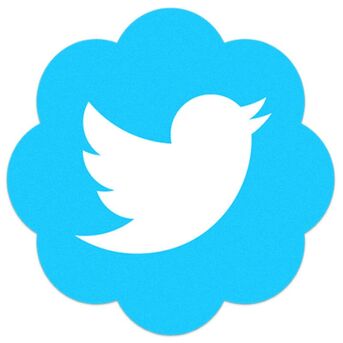Why Twitter verification is crucialIf you’ve spent any amount on Twitter at all, you will have seen the blue checkmark icon next to some accounts’ names. The blue badge proves that the identity of the person managing the account has been officially verified by Twitter. But if it’s all just about confirming your ID and contact details, why is Twitter verification such a big deal? To understand the importance of becoming verified on Twitter, you need to look into what the blue badge indicates. What does it say about your account on a deeper level? It makes you look important As the Twitter Help Center puts it, “The blue verified badge on Twitter lets people know that an account of public interest is authentic.” Note the words ‘of public interest’. Having the blue badge next to your name immediately indicates that it’s less of a personal-use account and more of an official communication channel for your brand. ‘Brand’ here can refer both to a company or product or to the personal brand of an influencer or a person otherwise existing in the public community. The badge matters, therefore, because it directly marks you as someone in whom the public should take an interest – indirectly driving your follower count upwards. If a Twitter user comes across one of your Tweets, they’ll be more likely to check out your profile – if nothing else, to see why you’re an ‘account of public interest’. It suggests you’re worth imitating Although the blue badge is an indication of public interest accounts, that’s not its primary purpose. The reason why Twitter verification exists is to prevent fraud and impersonation of brands and individuals with a public presence. It makes sense that a safeguard like this would need to be put in place. There’s no shortage of fake accounts pretending to be famous people and company reps, and these impersonators can do a lot of damage to the brand. Perhaps the most well-known example of this is the @EastwoodUSA Twitter account, on which an individual claiming to be Clint Eastwood spoke out on a range of topics, including controversial political issues. Twitter suspended the account in 2016, when it was proven to be fraudulent. Having the verified badge next to your name, therefore, suggests to other users that you’re at risk of being impersonated. And of course, no one is going to impersonate your average person – it’s only the most powerful, popular people that are vulnerable to impersonation. In this way, Twitter verification makes you all the more important and influential in the eyes of other users. And of course, if you are a big enough brand to worry about impersonation – or likely will be in the future – Twitter verification is a necessary safeguard. It causes you to stand out Reserved for an exclusive group of users, the blue verification badge is a relatively rare sight on Twitter. As such, it will make your account and your Tweets stand out from the crowd: you’re far more likely to spark the interest of a user casually browsing their feed if you’ve been verified. Your potential audience is not only going to assume that you’re important, but also that what you’re saying is both true and important. This is particularly significant for influencers looking to expand their following on Twitter. It makes you easier to find Picture this: you’re a casual Twitter user, and a co-worker has told you about a Twitter account you should check out. You search for the username as you remember it, and two very similar results come up. One of them is a verified account, the other is not. Which one are you more likely to visit first? By getting the blue badge on Twitter, you’re guaranteed to stand out even when someone has a very similar username. Having a verified account gives you a degree of credibility and noteworthiness that places you a cut above the regular user. Naturally, not everyone can get a verified badge – otherwise, it wouldn’t matter all that much anymore. A solid presence on Twitter won’t suffice, either – since verification involves proving that you’re a person of ‘public interest’, a Wikipedia page and a series of press mentions and features are likely to be necessary. If you’re looking to get verified on Twitter, but don’t know where to start, hire a professional PR agency to handle it for you quickly and efficiently. Read Now  If you’ve spent any amount on Twitter at all, you will have seen the blue checkmark icon next to some accounts’ names. The blue badge proves that the identity of the person managing the account has been officially verified by Twitter. But if it’s all just about confirming your ID and contact details, why is Twitter verification such a big deal? To understand the importance of becoming verified on Twitter, you need to look into what the blue badge indicates. What does it say about your account on a deeper level? It makes you look important As the Twitter Help Center puts it, “The blue verified badge on Twitter lets people know that an account of public interest is authentic.” Note the words ‘of public interest’. Having the blue badge next to your name immediately indicates that it’s less of a personal-use account and more of an official communication channel for your brand. ‘Brand’ here can refer both to a company or product or to the personal brand of an influencer or a person otherwise existing in the public community. The badge matters, therefore, because it directly marks you as someone in whom the public should take an interest – indirectly driving your follower count upwards. If a Twitter user comes across one of your Tweets, they’ll be more likely to check out your profile – if nothing else, to see why you’re an ‘account of public interest’. It suggests you’re worth imitating Although the blue badge is an indication of public interest accounts, that’s not its primary purpose. The reason why Twitter verification exists is to prevent fraud and impersonation of brands and individuals with a public presence. It makes sense that a safeguard like this would need to be put in place. There’s no shortage of fake accounts pretending to be famous people and company reps, and these impersonators can do a lot of damage to the brand. Perhaps the most well-known example of this is the @EastwoodUSA Twitter account, on which an individual claiming to be Clint Eastwood spoke out on a range of topics, including controversial political issues. Twitter suspended the account in 2016, when it was proven to be fraudulent. Having the verified badge next to your name, therefore, suggests to other users that you’re at risk of being impersonated. And of course, no one is going to impersonate your average person – it’s only the most powerful, popular people that are vulnerable to impersonation. In this way, Twitter verification makes you all the more important and influential in the eyes of other users. And of course, if you are a big enough brand to worry about impersonation – or likely will be in the future – Twitter verification is a necessary safeguard. It causes you to stand out Reserved for an exclusive group of users, the blue verification badge is a relatively rare sight on Twitter. As such, it will make your account and your Tweets stand out from the crowd: you’re far more likely to spark the interest of a user casually browsing their feed if you’ve been verified. Your potential audience is not only going to assume that you’re important, but also that what you’re saying is both true and important. This is particularly significant for influencers looking to expand their following on Twitter. It makes you easier to find Picture this: you’re a casual Twitter user, and a co-worker has told you about a Twitter account you should check out. You search for the username as you remember it, and two very similar results come up. One of them is a verified account, the other is not. Which one are you more likely to visit first? By getting the blue badge on Twitter, you’re guaranteed to stand out even when someone has a very similar username. Having a verified account gives you a degree of credibility and noteworthiness that places you a cut above the regular user. Naturally, not everyone can get a verified badge – otherwise, it wouldn’t matter all that much anymore. A solid presence on Twitter won’t suffice, either – since verification involves proving that you’re a person of ‘public interest’, a Wikipedia page and a series of press mentions and features are likely to be necessary. If you’re looking to get verified on Twitter, but don’t know where to start, hire a professional PR agency to handle it for you quickly and efficiently. Comments are closed.
|
- Home
- Team
- Tik Tok
- Instagram & FB Verification
- Verified Instagram Accounts
- Instagram Usernames & Brokerage
- Verified Instagram Username Change
- Celebrity Instagram Growth Giveaways
- Verified Instagram Accounts With Desired Username
- Recover Disabled or Hacked Accounts
- Linkedin Username Claim Service
- Acquire Premium Accounts
- YouTube Verification
- Instagram Ban Service
- Twitter Verification
- Become a Forbes Contributor
- Write For Entrepreneur.com
- Verified Twitter Username Change
- Verified Facebook Page With Desired Username
- Instagram Growth
- Reputation Management
- Snapchat Verification
- Famous Birthdays
- Wikipedia Page Creation
- Google Knowledge Panel
- Spotify promotion
- Google News Approval Service
- PR for Influencers & Content Creators
- PR for Brands & Startups
- PR for Crypto, Blockchain & DeFi Companies
- PR for Musicians & Artists
- Partner Program
- Careers
- Blog Articles
- Clients
- Contact
Contact
Only Official Email Address [email protected]Always email directly via our official email to make sure you're liaising with us!
|
|



